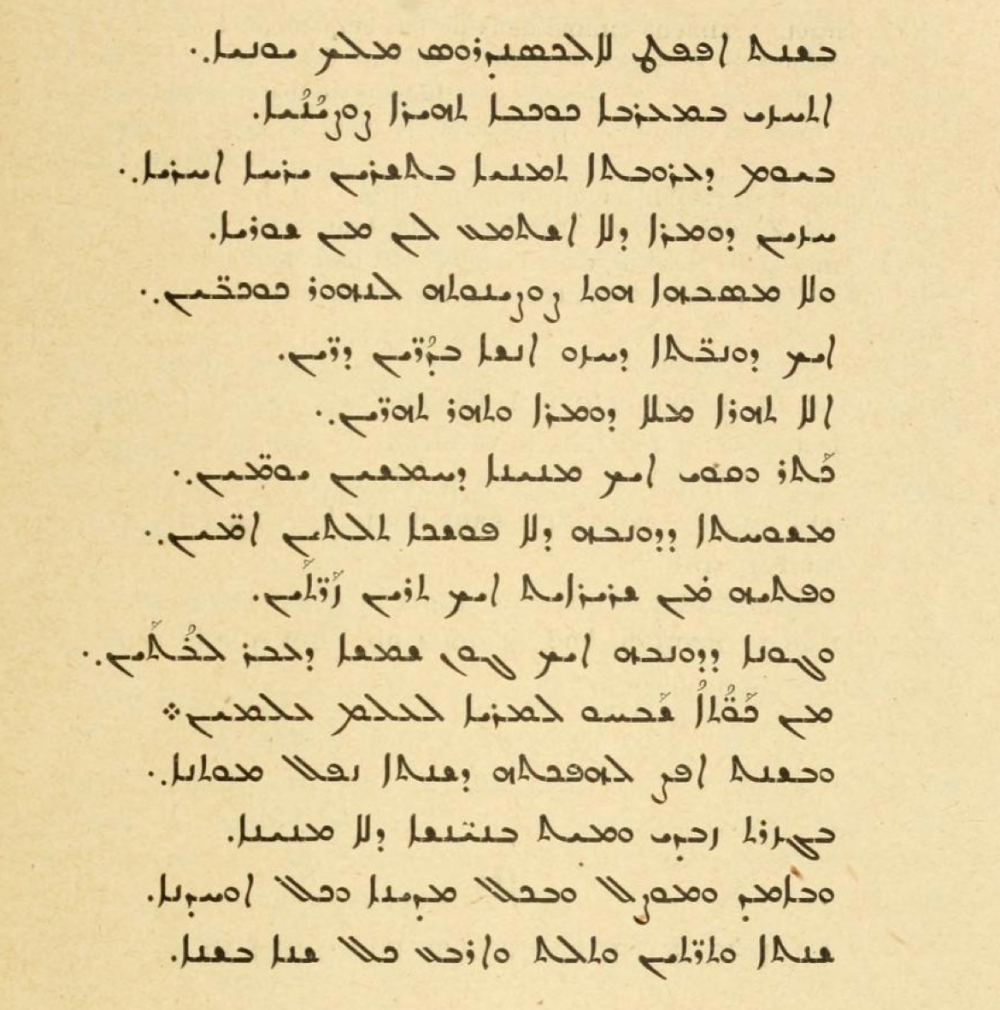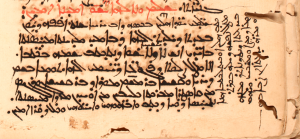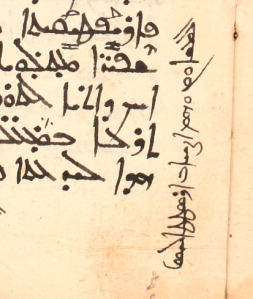(Apologia: Some background on the writing of this post. I wrote most of this post and translated the text when under the impression that there was not yet any English translation of it. I had stumbled upon Nau’s article while perusing the Syriac contents of ROC at Aramaico. But on the day I was finishing up the post, I happened to be looking at something completely unrelated in The Hidden Pearl, vol. 2, and I found to my surprise that there was a partial translation of this text in English! (If I had noticed it there before, I’d forgotten.) It will be found there on p. 258. Even though the translation below is not, then, the first English witness to this interesting text, it is, I think, the first complete English translation, and so I have decided to go ahead and share it. Being freely accessible online, it may also bring word of this text to a broader audience, and the other remarks and the vocabulary list will perhaps be of interest and use to some readers.)
Some time ago I published and translated two related notes in Syriac on some meteorological events from the sixteenth century (see also a later weather report in Syriac here). It happens that a more momentous sixteenth-century cosmic event, complete with a plague, was also recorded in Syriac: the Great Comet of 1577. The industrious François Nau first brought attention to the text with his publication and FT in his “Une description orientale de la comête de novembre de 1577,” ROC 27 (1929-1930): 212-214 (available here). Below I give the Syriac text, which is written in rhymed prose, followed by an English translation (which is not in rhymed prose!).
Comets are discussed here and there in Syriac cosmological literature. For example, in the Syriac version of the De Mundo, Sergius of Rēšʿaynā simply uses the Greek word (qwmṭʾ, qwmṭs; see McCollum, A Greek and Syriac Index to Sergius of Reshaina’s Version of the De Mundo, p. 104). Similar to the term below, Jacob bar Shakko has kawkbē ṣuṣyānāyē (see F. Nau, “Notice sur le livre des trésors de Jacques de Bartela, Évèque de Tagrit,” Journal Asiatique, 9th series, 7 (1896): 286-331, here 328). Similar is Bar ʿEbrāyā’s language in his “Book of Meteorology” in the Butyrum Sapientiae; see H. Takahashi, Aristotelian Meteorology in Syriac, pp. 148-149, 190-191. Via Bar ʿEbrāyā, too, we have the same terminology in a Syriac fragment based on “Ptolemy’s” Liber fructus; the fragment begins, āmar gēr Pṭolomos ba-ktābēh haw d-asṭrologia pērā qrāy(hy) (see F. Nau, “Un fragment syriaque de l’ouvrage astrologique de Claude Ptolémée intitulé le livre du fruit,” ROC 28 (1931-1932): 197-202, avail. here). (See further Payne Smith, Thes. Syr. col. 3382.)

Syriac text from ROC 27, p. 213
The events here are dated beginning in Tišrin II, 1889 AG, which corresponds to November, 1577 CE. The plague at the end of the text is dated throughout the years 1890-1893 AG (= 1578/9-1581/2 CE).
In the year 1889 of Alexander, Greek king,
A marvelous comet appeared in the west.
On Friday, the 8th of the month Tišrin II,
We saw a wonder that we had never before heard of,
And its cometness was not like the light of stars,
[Nor] as the tails [of comets] that people had seen in various generations:
No, it was a marvel full of wonder and a marvel of marvels.
It lasted and continued about fifty days.
The size of its tail was undoubtedly thirty cubits,
And its width was surely about two of our spans.
The color of its tail was like the color of the sun, which crosses our houses.
From the windows praise the Lord forever!
And in the year 1890 [AG], in the next year, a plague occurred
In Gāzrat Zabday, and numberless people died,
Also in Amid, Mosul, and in every city and every province:
[It lasted] a year, two, three, and four, each and every year.
For students of Syriac, here is a running list of vocabulary to the text:
ṣuṣyānāyā lock-like, having locks (of hair) < ṣuṣitā lock of hair (cf. “comet” κομήτης < κόμη)
dummārā marvel, wonder
sbh D to liken (here pass. ptcp)
ṣuṣyānutā cometness
dunbtā tail
te/ahrā wonder, miracle
puššākā uncertainty (d-lā puššākā certainly, undoubtedly)
ammtā cubit
zartā span (½ cubit)
ptāyā width
gawnā (cstr ES gon, WS gwan; see Nöldeke § 98) color, manner
bāttayn pl of baytā + 1cp
kawwtā window (in BibAram Dan 6:11)
hepktā d-ša(n)tā the following year
mawtānā plague, pestilence
Gāzrat Zabday cf. Payne Smith, Thesaurus Syriacus, cols. 702-703; Wright, Cat. Syr. Brit. Mus., vol. 3, p. 1339)
uḥdānā province
šnā abs of ša(n)tā
As anyone who frequents this blog knows, manuscripts can be much more than simple receptacles for the main texts that their scribes copied. When present, colophons, notes, &c., may make a manuscript even more valuable and interesting. Here is a case in point. On f. 241r of SMMJ 211, a fifteenth-century copy of Bar ʿEbrāyā’s Chronography (secular & eccles.), are two later meteorological reports from different hands, neither the scribe’s.

Notes in outer column of SMMJ 211, f. 241r.
The first note says roughly in English:
In the year 1814 (= 1502/3 CE) AG, in the month of Ḥzirān, there was a white meteor like the darkest night in the middle of the air for about an hour in the day, and everyone [lit. the whole world] saw it. And in the same year, on the feast of St. Jacob, on the 29th of the month of Tammuz, there was great and powerful thunder before midday, and with it were white clouds (ʿnānā), yet without a mist (ʿaymā) in the air, or rain, and this thunder continued roaring for about an hour of the day. They heard its sound throughout the region all the way to Gāzartā and the valley, and many people were frightened of its sound and fell on their faces. While the Lord shows us these signs for us to be repentant, our insolent and refractory heart neither repents nor is softened. May the Lord not repay us according to our evils, but according to the multitude of his mercy — amen — and his grace.
And from almost seven decades later, the second note (in less careful handwriting) says:
In the year 1882 AG (= 1570/1 CE) the clouds thickened and much rain appeared in Ṭur ʿĀbdin with terrible thunder, and intense lightning came down for six days in the month of Āb during the Feast of Booths in the villages, one of which is called Zāz, before the outer land of the Church of Mar Dimeṭ, and this lightning came down upon a house near that church with wood and straw inside it, and the house caught fire [with] all the firewood and straw.
(For the Church of Mar Dimet in Zaz, see a picture here.)
Update: Thanks to Thomas Carlson for the suggestion about PQʿTʾ (valley) in the first note, which I initially read as an unidentified place-name PWʿTʾ. The scribe writes waw and qop with little difference.
Ibn Sīnā (see also here, here, from the Enc. Iranica here, and specifically for metaphysics, here) stands among the most well known and most influential of philosophers who have written in Arabic, and his influence was hardly confined to the intellectual worlds where Arabic or Persian were the means of communication. From the twelfth and thirteenth centuries he was read in Latin — several volumes of the Latin witness to Ibn Sīnā have appeared since 1972 in editions by Simone van Riet (Brill) — and reflections of his work can be found in the writers of the Syriac Renaissance of the eleventh to the thirteenth centuries, especially in the voluminous work of Bar ʕebrāyā. Alongside the Qānūn fī ‘l-ṭibb may be mentioned especially his encyclopedic Kitāb al-šifāʔ, Dāneš-nāma (or Dānišnāma-i ʕalāʔī, in Persian, for the prince ʕalāʔ al-Dawla see here), and the Kitāb al-išārāt wa-‘l-tanbīhāt; the last mentioned work was translated into Syriac by Bar ʕebrāyā and there are two late copies with parallel Garšūnī and Syriac available at HMML: CFMM 550 and MGMT 20 (both twentieth century). John bar Maʕdani (d. 1263), a contemporary of Bar ʕebrāyā, penned two poems on the soul, one (or both) of which goes by the name of “The Bird” (pāraḥtā). I have recently cataloged an East Syriac manuscript of the sixteenth century that contains these two poems (and another, “On the Way of the Perfect”): it was copied in Gāzartā and completed on Aug. 10, 1866 AG/962 AH (= 1555 CE). The scribe, named Yawsep, rightly notes in the margin at the beginning of both of these poems that Bar Maʕdani is following Ibn Sīnā on this theme. The latter had written “a treatise, the Bird, an allegory in which he describes his attainment of the knowledge of the truth” (risālat al-ṭayr. marmūza yaṣif fīhā tawaṣṣula-hu ilá ʕilm al-ḥaqq; see Gohlman, pp. 98-99). Here is the marginal note to the first poem, that to the second being much less legible:

CCM 24, f. 112v, marginal note
Bar Sini [sic], the Muslim [hāgārāyā] philosopher, made a treatise [Syr. eggartā = Arb. risāla], the thought of which he somewhere directs to the subject at hand.
Here are the rubric and first lines of Bar Maʕdani’s first poem on the soul from this manuscript:

CCM 24, f. 112v.
Bibliography (selected!)
Achena, M. and Henri Massé. Le livre de science (Danishnama-yi ‘Ala’i) I: Logique, Métaphysique II: science naturelle, mathématique. Paris, 1986.
Anawati, G. La Métaphysique du Shifa’ I-IV et V-X. Paris, 1978-86.
Furlani, Giuseppe. “Avicenna, Barhebreo, Cartesio.” Rivista degli Studi Orientali 14 (1933): 21-30.
________. ”La psicologia di Barhebreo secondo il libro La Crema della Sapienza.” Rivista degli Studi Orientali 13 (1931-1932): 24-52.
________. “La versione siriaca del Kitâb al-išârât wat-tanbîhât di Avicenna.” Rivista degli Studi Orientali 21 (1945): 89-101.
Goichon, A.-M. “Ibn Sīnā.” In Encylopaedia of Islam, 2d ed., vol. 3, 941-947.
________. Lexique de la langue philosophique d’Avicenne. Paris, 1938.
________. Livre de directives et remarques (al-Isharat wa’l-Tanbihat). 2 vols. Paris, 1951.
Gohlman, William E. The Life of Ibn Sina: A Critical Edition and Annotated Translation. Albany, 1974.
Gutas, Dimitri. Avicenna and the Aristotelian Tradition. Leiden/Boston, 1988.
Hasse, Dag. Avicenna’s De Anima in the Latin West. London, 2000.
Heath, Peter. Allegory and Philosophy in Avicenna (Ibn Sînâ). Philadelphia, 1992.
Inati, Shams. Ibn Sina on Mysticism (al-Isharat wa’l-Tanbihat namat IX). London, 1998.
________. Remarks and Admonitions Part One: Logic (al-Isharat wa’l-Tanbihat: mantiq). Toronto, 1984.
Janssens, Jules. Bibliography of Works on Ibn Sina. 2 vols. Leiden, 1991-1999.
Janssens, Jules and Daniel de Smet, eds. Avicenna and His Heritage. Leuven, 2001.
Joosse, Nanne Peter. A Syriac Encyclopaedia of Aristotelian Philosophy: Barhebraeus (13th c.), Butyrum Sapientiae, Books of Ethics, Economy, and Politics. Aristoteles Semitico-Latinus 16. Leiden/Boston, 2004.
Mcginnis, Jon. Avicenna, The Physics of The Healing. 2 vols. Provo, 2009.
Marmura, Michael. The Metaphysics of Avicenna (al-Ilahiyyat min Kitab al-Shifa’). Provo, 2004.
________. “Plotting the Course of Avicenna’s Thought.” Journal of the American Oriental Society 111 (1991): 333-42.
Michot, Yahya. “La pandémie avicennienne.” Arabica 40 (1993): 287-344.
Morewedge, Parviz. The Metaphysica of Avicenna (Ilahiyyat-i Danishnama-yi ‘Ala’i). New York, 1972.
Rahman, F. Avicenna’s De Anima (Fi’l-Nafs). London, 1954.
Rashed, Roshdi and Jean Jolivet, eds. Études sur Avicenne. Paris, 1984.
Reisman, D. and Ahmed al-Rahim, eds. Before and After Avicenna. Leiden/Boston, 2003.
N. G. Siraisi, Avicenna in Renaissance Italy: The Canon and Medical Teaching in Italian Universities after 1500. Princeton, 1987.
Takahashi, Hidemi. Aristotelian Meteorology in Syriac: Barhebraeus, Butyrum Sapientiae, Books of Mineralogy and Meteorology. Aristoteles Semitico-Latinus 15. Leiden/Boston, 2004.
________. “The Reception of Ibn Sīnā in Syriac: The Case of Gregory Barhebraeus.”, In Before and After Avicenna (see above), 249-281.
Teule, Herman G.B.”Renaissance, Syriac.” GEDSH 350-351.
________. “The Transmission of Islamic Culture to the World of Syriac Christianity: Barhebreaus’ Translation of Avicenna’s kitâb al-išârât wa l-tanbîhât. First Soundings.” In J.J. van Ginkel, H.L. Murre-van den Berg, and T.M. van Lint, eds. Redefining Christian Identity: Cultural Interaction in the Middle East since the Rise of Islam. Orientalia Lovaniensia Analecta 134. Leuven: Peeters, 2005. Pages 167-184.
________. “Yuḥanon bar Maʿdani.” GEDSH 444.
Watt, John W. Aristotelian Rhetoric in Syriac: Barhebraeus, Butyrum Sapientiae, Book of Rhetoric. Aristoteles Semitico-Latinus 18. Leiden/Boston, 2005.
________, “Graeco-Syriac Tradition and Arabic Philosophy in Bar Hebraeus.” In H.G.B. Teule, C.F. Tauwinkl, R.B. ter Haar Romeny, and J.J. van Ginkel, eds. The Syriac Renaissance. Eastern Christian Studies 9. Leuven/Paris/Walpole, Mass., 2010. Pages 123-133.
HMML’s partnership with Saint Mark’s Monastery, Jerusalem, to digitize their manuscript collection has yielded high-quality digital images of close to 300 manuscripts. A hard drive of the latest files arrived here last week and they have been uploaded to the server. The collection was cataloged in the early numbers of Oriens Christianus by G. Graf, A. Baumstark, and Ad. Rücker, and in the late 1980s thirty-one manuscripts from this collection were microfilmed by BYU and cataloged by William Macomber; scans of these microfilms have been graciously made available at the CPART site. Until the collection is again examined closely, it will not be certain how much the Saint Mark’s collection has changed from these earlier efforts at scrutiny and description, i.e. which manuscripts have been lost, and which have been gained.

SMMJ 232, f. 148v
As is relatively well known thanks to the work of the earlier German scholars and of BYU and Macomber, the Saint Mark’s collection has several notable manuscripts. I hope that I will be able to adequately highlight some of these in the future here, but today I share with you a bit of information (and images) of two manuscripts of Bar ˤEbrāyā’s philosophical work, each copy containing his Tēgrat Tēgrātā (The Treatise of Treatises), Ktābā da-Swād Sofia (The Conversation of Wisdom), and Ktābā d-Bābātā (The Pupils [of the Eye]). The manuscripts are numbered 231 and 232, with 232 being the older and dated 1878 AG (= 1566/7 CE) on f. 196r, but dated to the month of Āb (August) in 1885 AG (1574) on f. 148v; see the image to the right. The scribe of this is Tomā bar Murād bar Giwargis of Klibin, near Mardin, and “my teacher and our teacher Tomā” is named in the colophon on f. 197r, that part copied earlier is the work of another scribe. Completion dates this divergent for parts of one manuscript are not hard to fathom when we realize that they were apparently first not of the same manuscript. Near the beginning of The Book of the Pupils, ff. 163-172 are marked as the second quire (the first not explicitly marked), while the first text in the whole manuscript, The Treatise of Treatises, takes up sixteen quires, which are marked, itself. It seems that up to f. 152 was originally separate from the rest of the book, and the two parts were later joined together. The later manuscript is dated on f. 308r to Tāmuz (July) 9, 1882, and it was most probably copied from no. 232. It, too, begins with The Treatise of Treatises, which was copied (up to f. 139) in the way of some other works of Bar ˤEbrāyā’s, with Syriac and Arabic (Garšūnī) having been copied side-by-side, but here there is no full Arabic version of The Treatise, only select words and sentences. Some — probably most or all, but I have not studied the copies closely — of these translated bits also appear in the sixteenth-century manuscript, but they do not there have such a broad space; they are merely written in the margins. Images of corresponding parts near the beginning of the work are below, with the comments explaining in Arabic what “Peripatetic” means.

SMMJ 232, f. 2r

SMMJ 231, f. 9v
Note
Abundant bibliographic and manuscript information on all three of these works by Bar ˤEbrāyā will be found in H. Takahashi, Barhebraeus: A Bio-Bibliography (Piscataway, 2005), 254-265, to which I would make the following additions based on my work in the Church of the Forty Martyrs collection:
- The Conversation of Wisdom
- CFMM 548, dated 1891, has Syriac and Garšūnī versions of the work.
- CFMM 546, dated 1879 and copied in Edessa.
- CFMM 547, dated 1923 and also copied in Edessa.






